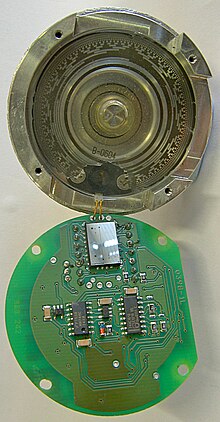
Back مرمز دوراني Arabic Dövri enkoder Azerbaijani Энкодэр BE-X-OLD Codificador rotatiu Catalan Drehgeber German Codificador rotatorio Spanish Pöördkooder Estonian رمزگذار چرخشی Persian Kulma-anturi Finnish Codeur rotatif French

A rotary encoder, also called a shaft encoder, is an electro-mechanical device that converts the angular position or motion of a shaft or axle to analog or digital output signals.[1]
There are two main types of rotary encoder: absolute and incremental. The output of an absolute encoder indicates the current shaft position, making it an angle transducer. The output of an incremental encoder provides information about the motion of the shaft, which typically is processed elsewhere into information such as position, speed and distance.
Rotary encoders are used in a wide range of applications that require monitoring or control, or both, of mechanical systems, including industrial controls, robotics, photographic lenses,[2] computer input devices such as optomechanical mice and trackballs, controlled stress rheometers, and rotating radar platforms.
- ^ Murray, Mike (15 December 2019). "How Rotary Encoders Work". The Geek Pub. Retrieved 3 September 2019.
- ^ "New - Rotary Encoder". Archived from the original on 2013-10-05. Canon video camera lens, used for zoom and aperture control
© MMXXIII Rich X Search. We shall prevail. All rights reserved. Rich X Search